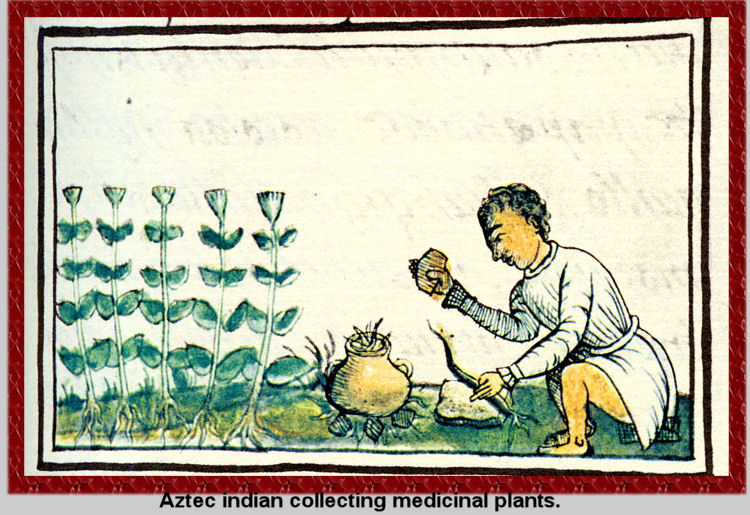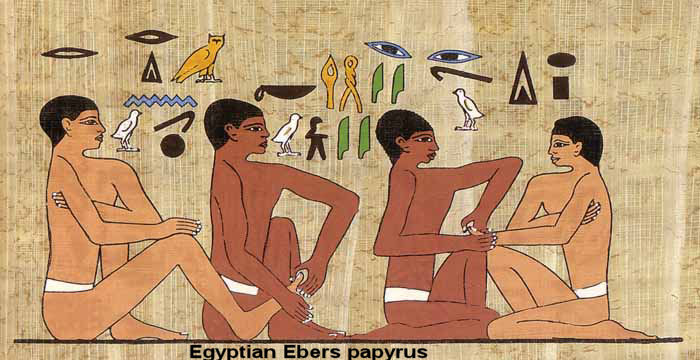
|

|
 |
|
MEDICINE FROM NATURE |
 Plants and herbs have been used to treat diseases going back at least 65,000 years!
Plants and herbs have been used to treat diseases going back at least 65,000 years! The first known written records of the use of medicinal plants; done by the Egyptians, Aztecs, Incas and
Sumerians;
date back at least 5,000 years.
The first known written records of the use of medicinal plants; done by the Egyptians, Aztecs, Incas and
Sumerians;
date back at least 5,000 years. Especially the Egyptians had a rational and scientific approach to medicine as was written in The Edwin Smith Papyrus, an ancient
Egyptian medical text, probably from 3,000 – 2,500 BC.
Especially the Egyptians had a rational and scientific approach to medicine as was written in The Edwin Smith Papyrus, an ancient
Egyptian medical text, probably from 3,000 – 2,500 BC.
Civilizations in India and China still relay, after many thousand of years, for a great part on herbal medicine.  Traditional Chinese Medicine and Ayurvedic (the ancient East Indian system of health care) are many thousands of years old
but still very relevant today.
Traditional Chinese Medicine and Ayurvedic (the ancient East Indian system of health care) are many thousands of years old
but still very relevant today.However there also are more old and tried medicinal systems. Take Jamu for instance (the ancient Indonesia system of health); they used plants and herbs stimulating the body’s immune system to produce antibodies. Using medicinal plants is not something of the past or old fashioned; on the contrary. The far greater part of the world's population up to this day, relies heavily on plant material; herbs and extracts as medicines. According to estimates of The World Health Organization (WHO), 80 percent of the world’s population still uses traditional remedies, plants included, as their primary health care. Matter of fact, at least 25% of today's pharmaceutical drugs still have plant ingredients and/or (synthetic) derivates from these. Among the 120 active compounds currently isolated from higher plants and extensively used in modern medicine today, 80 percent show a positive correlation between their modern therapeutic use and the traditional use of the plants from which they are derived. However, modern medicine as we know is moving away from plants as the core of its medicines.  The total number of plants worldwide is unknown; new species are still being identified.
The total number of plants worldwide is unknown; new species are still being identified.There are an estimated 310,000 to 422,000 plant species on earth and many have or may have medicinal applications.  There is widespread destruction of tropical rainforest ecosystems and extinction of numerous plant and
animal species is
happening at this very moment everywhere on earth; especially in the tropics.
There is widespread destruction of tropical rainforest ecosystems and extinction of numerous plant and
animal species is
happening at this very moment everywhere on earth; especially in the tropics. The consequence may be that in the future fewer medicines against diseases such as cancer and HIV are being developed. In this century, between 94,000 and 144,000 species are at risk of dying out and many of these have not yet been named! According to a report published recently in the journal Science, between 22 and 47 percent of the world's plants are endangered. However, unfortunately botanists have still not compiled and catalogued many plant species. For many thousands of years plants have been the major source of medicine for mankind. Many of today's useful drugs find their origins in the earliest medical plant folklore. For instance, think of quinine (from Peruvian bark), morphine (from opium poppy), atropine (from deadly nightshade) and many others. China and India among others, have a very long and old tradition in the use of plants against many ailments and diseases. In the Amazon rainforest, many plants and herbs also have been used for thousands of years to cure, treat and prevent many illnesses and diseases. This practice continues up to the present day. |
Disclaimer: |